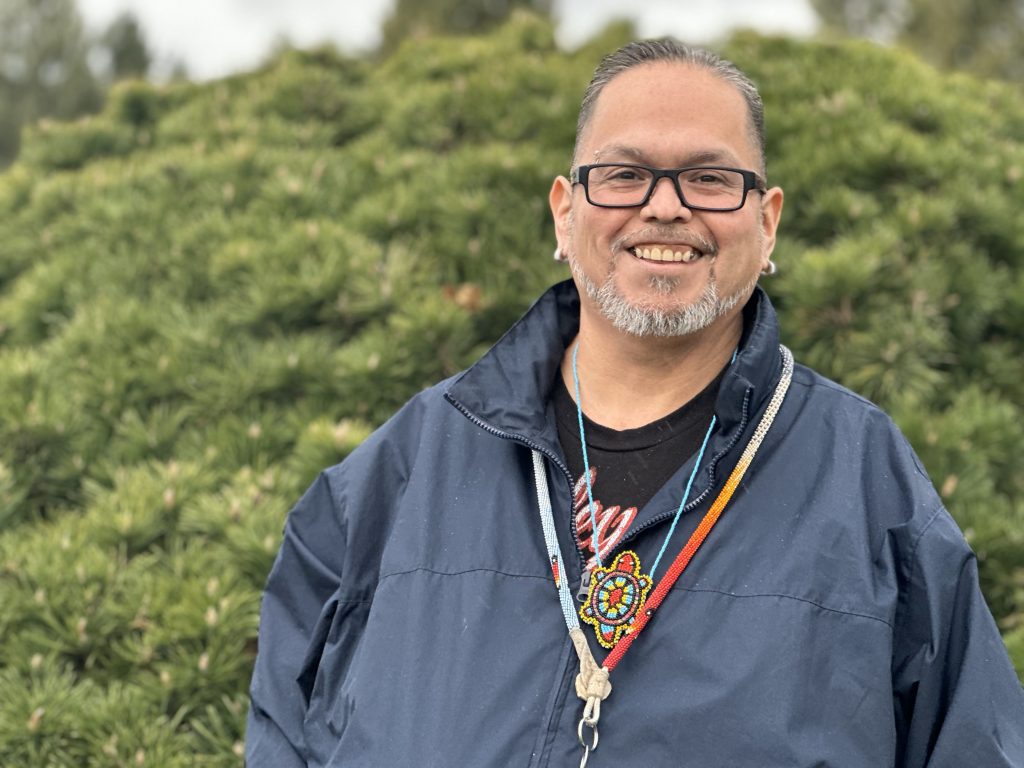The following interview is reprinted from DIVERSEcity’s Green Guide for Newcomers.
Earth Connection
An Indigenous perspective on our relationship with the land
Dennis Leon, Tsatsomtun, from the Kwantlen First Nation, shares an Indigenous perspective on environmentalism. As Cultural Lead and Advisor at Len Pierre Consulting, Dennis has a longstanding relationship with the community, sharing Indigenous knowledge while helping revitalize culture, tradition and language. We are grateful to Dennis for his teachings for newcomers on how to connect with and protect the earth.
What does the land mean to you?
As an Indigenous person, we believe that we are part of the land; this is where we come from. We don’t own it, but we have to protect it and keep the lands clean by using paper straws and earth-rendered materials avoiding microplastics. Perhaps the most important thing we have to take care of is the soil. The soil is the one that makes the plants grow. I like to talk about earthing — where you take your shoes and socks off and go stand in the water or sand, or go sit by a tree, to feel that connection physically and be one with nature just for a little while, so our spirit feels safe and connected. Once people fulfill their spiritual needs, they can continue on with what they have to do to survive.
Can you tell us more about that spiritual connection?
Our ancestors say that everything has shwxéli or spirit. Everything has a purpose, and so do we. We are all born with a gift, and we are sharing our gift with each other, and we learn from each other. Everything is spirited. We need to be connected more and love our surroundings because everything around us is beautiful. We call ourselves people of the land. The people went wherever the food went and took only what they needed. People start to lose their connection and forget this because of material things [points to his cell phone], but we live on some of the most beautiful land on the planet. We are all connected.
How can traditional Indigenous knowledge or practices inform newcomers on how to live better with the environment?
I would tell them to remember that everything in the soil, the dirt and the land is sacred. So:lh tèmèxw means land is sacred and anything that lives on it is sacred. Anytime we want to learn something we watch the animals and what they do. This is how we learn what’s good for us and what’s not good for us. We also need to lose colonized ways of thinking and let people who are non-Indigenous know that what happened in the past is not your fault, but the future now needs you.

Where do you think people can start when thinking about being green?
It all starts right here [points to his mind]. A daily thing for me is meditating. I also do intermittent fasting, where you eat only when you need to. And using reusable items, trying to use earth-rendered materials whenever possible. I have this water filter jug that has a filter on it that allows the body to absorb 80 per cent more of the nutrients, and I also make my own sauces instead of going to the store and getting multiple bottles. My family and I also use the bins and make sure we put the items in the right bin for compost, recycling and trash. It’s all about unlearning and relearning, and then after that it becomes a part of your routine.
What is the main message you would like newcomers to take from this conversation?
Have an open mind and an open heart about Indigenous teachings. It’s not just for us, it’s for everybody. Everybody has shwxéli “spirit “inside them. In my language we say, letsa maht (one mind), letsa thala (one heart), letsa shwxéli (one spirit). What we all need to do is have our mind and our heart and our spirit all in the same place.
Look at our list of Environmental Resources including the full Green Guide for Newcomers HERE.

